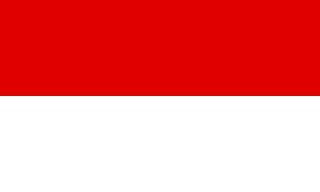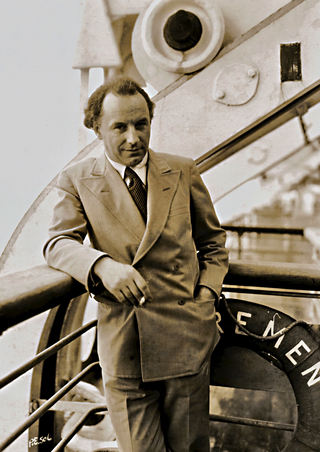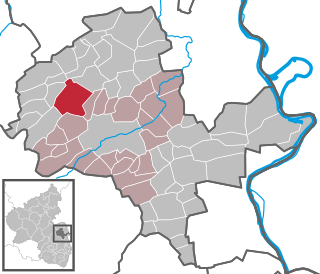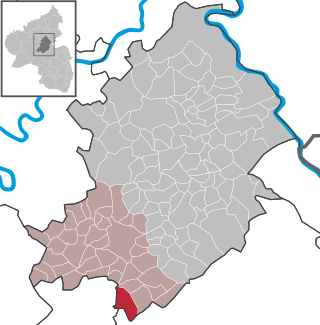
Hesse or Hessia, officially the State of Hesse, is a state in Germany. Its capital city is Wiesbaden, and the largest urban area is Frankfurt, which is also the country's principal financial centre. Two other major historic cities are Darmstadt and Kassel. With an area of 21,114.73 square kilometers and a population of over six million, it ranks seventh and fifth, respectively, among the sixteen German states. Frankfurt Rhine-Main, Germany's second-largest metropolitan area, is mainly located in Hesse.

Epidemic typhus, also known as louse-borne typhus, is a form of typhus so named because the disease often causes epidemics following wars and natural disasters where civil life is disrupted. Epidemic typhus is spread to people through contact with infected body lice, in contrast to endemic typhus which is usually transmitted by fleas.

Jakob Maria Mierscheid MdB has been a fictitious politician in the German Bundestag since 11 December 1979. He was the alleged deputy chairman of the Mittelstandsausschuss of the Bundestag in 1981 and 1982. According to his official biography, he was born in Morbach/Hunsrück, a very rural constituency in Rhineland-Palatinate. He is Catholic and a member of the Social Democratic Party of Germany.
Fictitious or fake entries are deliberately incorrect entries in reference works such as dictionaries, encyclopedias, maps, and directories, added by the editors as copyright traps to reveal subsequent plagiarism or copyright infringement. There are more specific terms for particular kinds of fictitious entry, such as Mountweazel, trap street, paper town, phantom settlement, and nihilartikel.

Goethe University Frankfurt is a public research university located in Frankfurt am Main, Germany. It was founded in 1914 as a citizens' university, which means it was founded and funded by the wealthy and active liberal citizenry of Frankfurt. The original name in German was Universität Frankfurt am Main. In 1932, the university's name was extended in honour of one of the most famous native sons of Frankfurt, the poet, philosopher and writer/dramatist Johann Wolfgang von Goethe. The university currently has around 45,000 students, distributed across four major campuses within the city.

Arnold Fanck was a German film director and pioneer of the mountain film genre. He is best known for the extraordinary alpine footage he captured in such films as The Holy Mountain (1926), The White Hell of Pitz Palu (1929), Storm over Mont Blanc (1930), The White Ecstasy (1931), and S.O.S. Eisberg (1933). Fanck was also instrumental in launching the careers of several filmmakers during the Weimar years in Germany, including Leni Riefenstahl, Luis Trenker, and cinematographers Sepp Allgeier, Richard Angst, Hans Schneeberger, and Walter Riml.

Budenheim is a municipality in the Mainz-Bingen district in Rhineland-Palatinate, Germany. Unlike other municipalities in Mainz-Bingen, it does not belong to any Verbandsgemeinde.

Runkel is a town on the river Lahn in Limburg-Weilburg district in Hesse, Germany.

Brechen is a municipality in Limburg-Weilburg district in Hesse, Germany.

Flonheim is an Ortsgemeinde – a municipality belonging to a Verbandsgemeinde, a kind of collective municipality – in the Alzey-Worms district in Rhineland-Palatinate, Germany.

Villmar is a market village and municipality in the Limburg-Weilburg district in Hesse, Germany. The community is the centre for quarrying and processing the so-called Lahn Marble.

Ludwigshöhe is an Ortsgemeinde – a municipality belonging to a Verbandsgemeinde, a kind of collective municipality – in the Mainz-Bingen district in Rhineland-Palatinate, Germany. It belongs to the Verbandsgemeinde Rhein-Selz.

Woppenroth is an Ortsgemeinde – a municipality belonging to a Verbandsgemeinde, a kind of collective municipality – in the Rhein-Hunsrück-Kreis (district) in Rhineland-Palatinate, Germany. It belongs to the Verbandsgemeinde of Kirchberg, whose seat is in the like-named town.

Lautzenhausen is an Ortsgemeinde – a municipality belonging to a Verbandsgemeinde, a kind of collective municipality – in the Rhein-Hunsrück-Kreis (district) in Rhineland-Palatinate, Germany. It belongs to the Verbandsgemeinde of Kirchberg, whose seat is in the like-named town.

Darwinius is a genus within the infraorder Adapiformes, a group of basal strepsirrhine primates from the middle Eocene epoch. Its only known species, Darwinius masillae, lived approximately 47 million years ago based on dating of the fossil site.
Pschyrembel most commonly refers to a popular medical dictionary in German, the Pschyrembel Clinical Dictionary .

Blair Witch is an American horror media franchise created by Daniel Myrick and Eduardo Sánchez, distributed by Artisan Entertainment and produced by Haxan Films that consists of three feature films and various additional media. The development of the franchise's first installment, The Blair Witch Project, started in 1993. Myrick and Sanchez wrote a 35-page outline of a story with the dialogue to be improvised. Filming began in 1997 and lasted eight days. The film follows the disappearance of three student filmmakers in the woods near Burkittsville, Maryland, while shooting a documentary on the local legend known as the "Blair Witch".

Neo Magazin Royale is a German satirical late-night talk show hosted by Jan Böhmermann. Produced in Cologne, it has been aired weekly on the ZDFneo channel since 31 October 2013. It is also made available in advance on the online ZDFmediathek internet page, with some segments uploaded to YouTube.

Knulp is a series of three tales by Hermann Hesse, published in 1915 by S. Fischer Verlag. The three episodes are about a vagrant called Knulp. Hesse wrote these tales between 1907 and 1914 and they are considered to be part of his “Gerbersau” cycle.


















